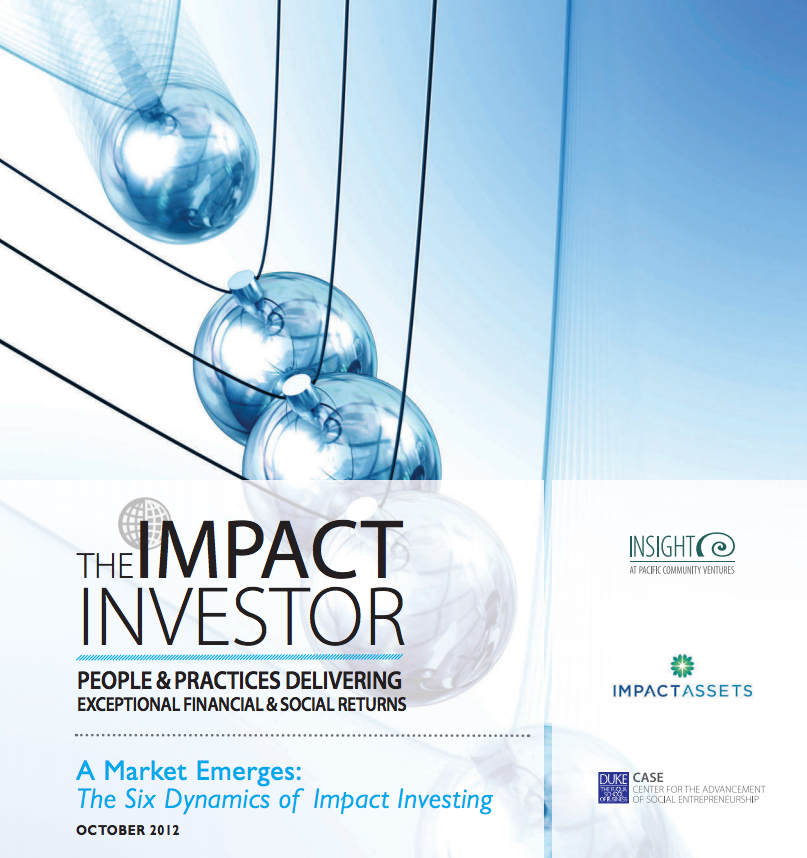Advancing Impact Investing Platforms… Promise and Peril!: We can’t always assume all investment strategies must scale
Impact Investing is often thought of as investing directly in mission driven for-profits or structuring new capital infusions for social enterprises that are nonprofit yet have a viable revenue model…
…or we think of Impact Investing as investing through funds such as those listed on the IA-50 or ImpactBase—
…yet for the field of impact investing to attain its true potential, its critical we explore how best to develop platforms that allow investors to both attain greater diversity of investment opportunities and “democratize” impact investing beyond the relatively high minimums many impact funds have to maintain.
That was the topic explored at a recent SOCAP12 panel discussion in San Francisco, building off a new research report – A Market Emerges: The Six Dynamics of Impact Investing – published by PCV InSight, together with CASE at Duke and ImpactAssets.
There are a number of issues to consider in our process of creating platforms that promise to scale impact investing. The first thing is to understand the relative appropriateness of “scaling” impact instruments for various opportunities—namely, as Tim Freundlich of ImpactAssets points out in the video below, some strategies simply do not lend themselves to scaling. We need to be both honest about that reality and clear on assessing those strategies that do lend themselves to scale. Impact Investing is not a single hammer looking for all the nails in the world—it is a diverse and dynamic approach to creating innovative applications of capital in appropriate ways to maximize potential impact. While the promise of investment platforms is, uh, promising, it is important we not start our discussion with the assumption that all investment strategies must scale!
Hilary Irby, of Morgan Stanley, built upon this idea when she made the great point that platforms actually offer the opportunity to blend various strategies in order to create impact across a portfolio. Furthermore, we need to understand how various impact opportunities need to be positioned effectively with the right market opportunities and that together this creates “an alignment of interests” between the investor and the investment opportunity.
Michelle Giddens of Bridges explored the question of whether in the process of scaling and moving “up” to a platform level one runs the risk of decreasing impact or, stated differently, do you by definition lose impact as you move toward Wall Street? Michelle stressed the need to identify meaningful opportunities first that have real impact and may only then be packaged for the right investor. She also addressed the question of how to frame the impact agenda without “scaring off” investors who may think that by definition such an agenda runs the risk of sacrificing financial performance.
Finally, in reflecting upon the experience of the Calvert Foundation, Lisa Hall explored the idea that we have now entered a period of fundamental paradigm shift. Lisa rejected the notion that there is a trade-off between social impact and financial performance, but rather an understanding of impact investing as a set of investment choices to be made by investors—and that for those building platforms of impact, the idea of impact itself becomes a core differentiator in the market and in terms of how investors opt to deploy capital.
Each of these perspectives offered a different angle on the challenge of creating impact investment platforms and helped all of us in attendance understand more about the appropriate role of platforms in the future of impact investing—as discussed in our paper, A Market Emerges: The Six Dynamics of Impact Investing.
Jed Emerson is the Chief Impact Strategist for ImpactAssets, a nonprofit financial services firm.
- Categories
- Uncategorized
- Tags
- impact investing, scale

